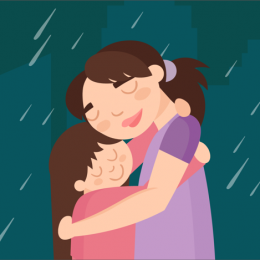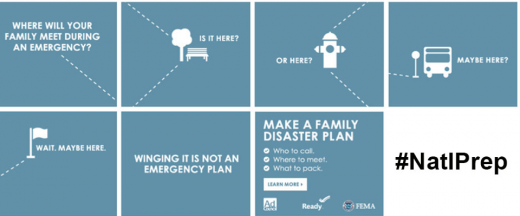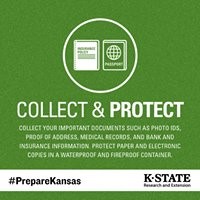September is National Preparedness Month. It is also our annual Prepare Kansas online challenge. Prepare Kansas 2017 will provide tips on getting financially prepared ahead of disasters and emergencies. This year’s program will be conducted through the K-State Research and Extension Facebook page. No registration is required, so Kansans and anyone interested in planning ahead for emergencies can follow on Facebook and this blog at any time during September, pick up handy information and interact with K-State extension specialists and agents. Today’s post is written by Bradford Wiles, Early Childhood Development Extension Specialist.

Disaster planning and preparedness can be difficult for families with young children. There are many issues to consider when confronting the challenges of disaster preparedness when it comes to young children. The true challenge stems from the need to make sure you keep children safe, without making them overly concerned about disasters. Balancing this involves knowing the children in your care, understanding developmentally appropriate practices, and understanding the goals for preparedness. Families can plan and prepare for emergencies in the following ways.
Develop a plan for emergencies
At home
Developing and practicing a plan for emergencies at home is crucial for any family’s success in navigating the perils of them. Practicing with children should also include some explanation of what to expect. Children need to be able to understand that it might get scary, and that even the adults might get scared. This information should be provided with the assurance that the adults will do everything they can to protect them and keep them safe. Children are naturally afraid of the uncertainty associated with emergencies, and it is important to help them understand that while they are scary, with good planning and listening skills, they can be safe. Practicing with children should be made to be fun, but making sure that they are listening and paying attention is an important aspect of safety in an emergency. Here are some games you can use with children to help plan for an emergency. Children need to know that while they are having fun, there is a serious aspect to the practicing. It is also important that we let them know that it is OK to be afraid, but that adequate preparation can help them feel like they are going to be safe. Providing a location where young children (4-6) can find their, and their parents/primary caregivers contact information (should they not be present), is a concrete action to take.
Finally, helping them feel like they can be safe, whether there are adults with them or not, can bolster their feeling prepared and acting safely during an emergency. We can do this by practicing their emergency response routines, encouraging them to talk about their plan, and being proactive in modeling our own emergency preparedness practices depending on the event. Fire preparedness requires evacuating, while weather events often require that we shelter in place. At the end of this post is a checklist of materials for adults and children.
At school/preschool
Creating a kit for your child or children to have when at school or preschool can help them during an emergency. You can start by creating a small emergency kit, and include essentials such as an information card with reunification locations, phone numbers and other contact information, out of town contacts, home address, and any special health or medical needs. Including some family pictures, including of the household pets, some toys, games, books, and other comfort items can be very helpful for making children feel calm and prepared in an emergency. Including non-perishable snacks children can consume when they are stressed can help. Make sure to have a mini first aid kit and a picture of the child in the kit so it can easily be given to the child. A change of clothes, and especially an extra set of shoes should be included as well. Keeping these in a waterproof container can also help make sure that they are available if they get wet.
Fire preparedness
One of the best ways to help children learn what to do during fires is to make the activities fun. The heaviness of disaster preparation can be offset by adults making games and fun competitions out of the tasks. For example, in preparing for escaping a house fire, getting low and crawling toward the nearest exit of the house is the best way to escape. This is a tremendous opportunity to get on the floor and have a crawling race on the way to the door, or you can make funny noises on the way. You can also have some fun during fire preparedness by practicing the, “stop, drop, and roll” technique. You can have this be a fun thing to do at random times in the day. Simply say, “Stop! Drop! Roll!”, and roll around on the floor together!
Weather event preparedness
There are multiple weather events that require preparedness, ranging from hurricanes to tornados, and including severe thunderstorms, and hail. These can create some anxiety in children, as they often require spending time in unusual places such as the basement, or an interior room of a house. To make sure that both the drills and the times that you need to stay in those places during inclement weather are tolerable, adults must be mindful of what children need to be distracted or entertained. When sheltering in place with children, having emergency supplies such as flashlights, water, a radio with fresh batteries, and other essentials is only half the battle! Having toys that children can play with, especially their favorite toy (if you can grab it before you have to take shelter). Making sure to include fun, engaging activities such as card games like “Go Fish”, puzzles, blocks, and other shared activities will help to pass the time.
Flooding preparedness
Flooding presents a threat that is very different from fire or wind events. The threat of flooding should be taken seriously by adults, as children cannot really make decisions about what to do. Flooding emergencies can be hard to predict, but making sure that you are able to evacuate your house should it be threatened, and that children can get to safe places is paramount. Flooding, whether due to hurricanes or severe storms, can present a huge challenge for emergency planning. Should hurricanes be threatening your area, be sure to check the storm surge maps (http://www.nhc.noaa.gov/nationalsurge/), and follow the storms at the National Hurricane Center (http://www.nhc.noaa.gov/). Please remember that storms do not merely threaten coastal areas, as they can remain quite powerful systems far inland. You can determine your flood risk by entering your address at the Federal Emergency Management Association website (https://msc.fema.gov/portal/search).
Summary
- Make sure to have an emergency plan that your children know, and materials for them to share with adults to help them find their caregivers in the event of separation
- Make sure to have toys and games for children in your safe spaces
- Be sure to convey the importance of being safe, and that it is OK to be afraid
- Teach children that they can be safe on their own, whether adults are present or not
- Have fun and practice, practice, practice!
Resources for children’s emergency preparedness:
- FEMA checklist of materials for adults and children
- Games for children’s preparation
- First aid kit contents checklist
- Preparedness supply list
- gov (FEMA) website for kids



